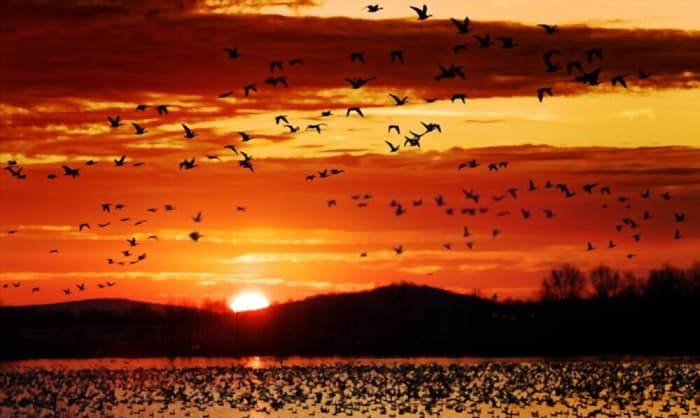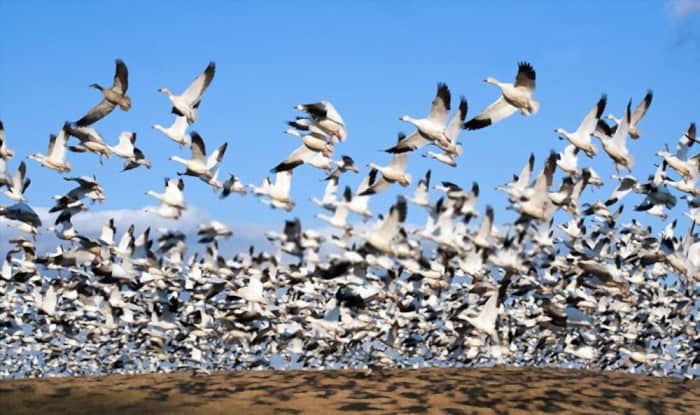Like clockwork, birds from the north migrate to the south during the fall season, and come back in the springtime. But how do birds know when to migrate? There are some factors that play a part in this process.
Temperature changes is one of them, and another indication to migrate is the gradual loss of food sources. The sunlight angle also plays a role, as well as the slight shift of vegetation color.
Learn more about this topic below.
Table of Contents
Essential Knowledge on Bird Migration
If you’re wondering when do birds start migrating, the simple answer is the fall. During winter, food sources start declining, and so avians escape the frost beforehand and spend their time in regions where they find warmth and abundant food sources.
When winter is over, flocks of migratory birds fly back to breed in the spring and summer. And the cycle goes on every year. However, not all avians migrate. Many bird species are year-round residents of their habitats, and they have the capability to combat the cold.
Migratory Birds
Do all birds migrate? Fact is, only 40% of the worldwide avian species participate in migration. Migratory birds are at risk of declining in number because of varying conservation laws in different states and countries. Plus, their long journey poses a major threat to their health and overall survival.
Thankfully, there are international bird conservation agreements between migration countries to protect these birds:
- Geese
- Snowy owl
- Woodpeckers
- Kingfishers
- Black-tailed godwit
- Pelicans
- Herons
- Black-headed bunting
- Common redpolls
- Pigeons
- Sandhill cranes
- Doves
- Wood stork
- Flycatchers
- Swifts
- Loons
- Hummingbirds
- Gulls
- Rails
- Citrine wagtail
- Eastern yellow wagtail
- Waterfowl
- Hawk-cuckoos
- Grebes
- Flamingos
- Loggerhead shrike
- Red knot
- Siberian rubythroat
- Snow bunting
- Common redshank
- Eurasian wryneck
- Northern shoveler
- Roseate spoonbill
- Northern harrier
- Peregrine falcon
Kinds of Migration
There are different kinds of bird migration. And it’s important to know that different birds engage in varying migration processes. Basically, the categorizing factor is the length or distance that the avians travel from their original location to a warmer place. Let’s take a look at the three kinds of migration:
- Short-distance migration – birds travel in small distances, such as high to low mountain elevation.
- Medium-distance migration – birds journey a few hundred miles to look for a better food source or to stay warm.
- Long-distance migration – 350 bird species in North America belong to this pattern. Avians travel from one side of the country to another, or to another country.
How Birds Sense When to Migrate
Above, we’ve discussed what season do birds migrate or fly south. But how do they know when to move habitats? Birds are able to sense when it’s time to go through their surroundings. Also, the bird’s body and behavior tells a tale on when to migrate.
1. Environmental Changes
When the food sources are slowly depleting, this is a major indication that the winter months are coming. There are changes in the environment such as a shift in sunlight positioning, decreasing temperature, and a slight change in color of trees, forests, and plants.
Additionally, it is said that birds have the ability to sense the shift in the magnetic field of the earth. Once they feel the change, the avians know that it’s time to leave their homes and seek temporary refuge in another state or country.
2. Body & Behavioral Changes
Aside from the environmental changes that trigger migration, a sure factor that causes birds to leave is their body and behavior. When it’s time to travel to a warmer climate, hormones are released inside the bird’s body.
Migrant avians become restless, and they start forming groups. And these same hormones are also responsible for preparing the migrant birds to return back north.
In fact, this kind of restlessness was given a name, Zugunruhe, pronounced as TSOOG-un-roo-uh. Birds experience migration anxiety weeks prior to leaving.
Their circadian clock is disrupted, so their normal sleep schedule is a mess. Plus, birds feel something brewing in a far place. And they simply feel like going there. They have an innate knowledge of when do birds migrate.
Preparation for Bird Migration
Birds prepare for migration by engaging in a feeding frenzy. They spend their time foraging for food and eating all day. They have a long trip ahead of them, and it’s crucial to have enough energy to fly for hours.
The foods that birds stuff on their bellies are turned to fat. Later on, the fats transition into energy, which is required for the long journey. Indeed, prior to migration, migrant birds get fatter intentionally.
After the Fattening Process
When the birds are fat and their stomachs are filled with a lot of food, they are now ready to migrate. They usually perch on high cable wires as a group to wait for the weather to signal the start of their journey.
The migrant birds are triggered by super calm weather to start flying south. Indeed, a flock of birds needs hemispheric migration strategy.
If the weather is bad or if it rains or gets cloudy, the birds let the weather pass and wait for the calm and clear skies.
Migrant birds fly south for the winter, that’s for sure. Like airplanes, birds also have their own migration path, which is referred to as flyways.
1. Flyways
Birds follow the flyways each year without fail, though unlike humans, they have no need for GPS or maps. They somehow use the sun, stars, and landmarks to find their way. After all, avians are intelligent creatures.
2. Homing Instinct
Every year, birds flock together and migrate to the same place without getting lost. This is mainly because the feathered creatures have a natural homing instinct. As young birds, they are able to imprint on their migration spots. That’s how they’re able to come back again and again.
3. Cluster N
Also, the avian species are blessed with a “cluster N” region in the brains. It plays a major role in figuring out which path is north.
4. Magnetic Map
Migrant birds have the capability to utilize the magnetic fields of the earth to navigate their route. The magnetic field can be felt strongly by the avians as they fly in the opposite direction of the equator. Because of this strong pull, birds can easily tell which way to go.
5. Olfactory Map
Additionally, birds are able to navigate the flyways in the fall thanks to their unique olfactory map. This means that they use their bills to reach their desired destination. Specifically, birds can actually smell the right path to the south and north when it’s time to go back.
Conclusion
Now you know that not all avians are migrants and how do birds know when to migrate. Avians can feel the migration time in their bones, sense it in the changes of the weather, and smell it.
When fall comes, birds prepare for their long journey by eating tons of food. They grow fat, and they form large flocks to fly together to their migration destination.
If you have further questions about bird migration, leave us a message. Also, kindly share this post so others may learn from it.
Before you go, don’t forget to check other interesting facts about birds:

George and I became friends after a birdwatching trip with our new group. And we have been enjoying every adventure together. When he told me the idea of establishing a site that shares our experiences and fun, I immediately agreed. After trials and errors, here we have Thayerbirding.
















